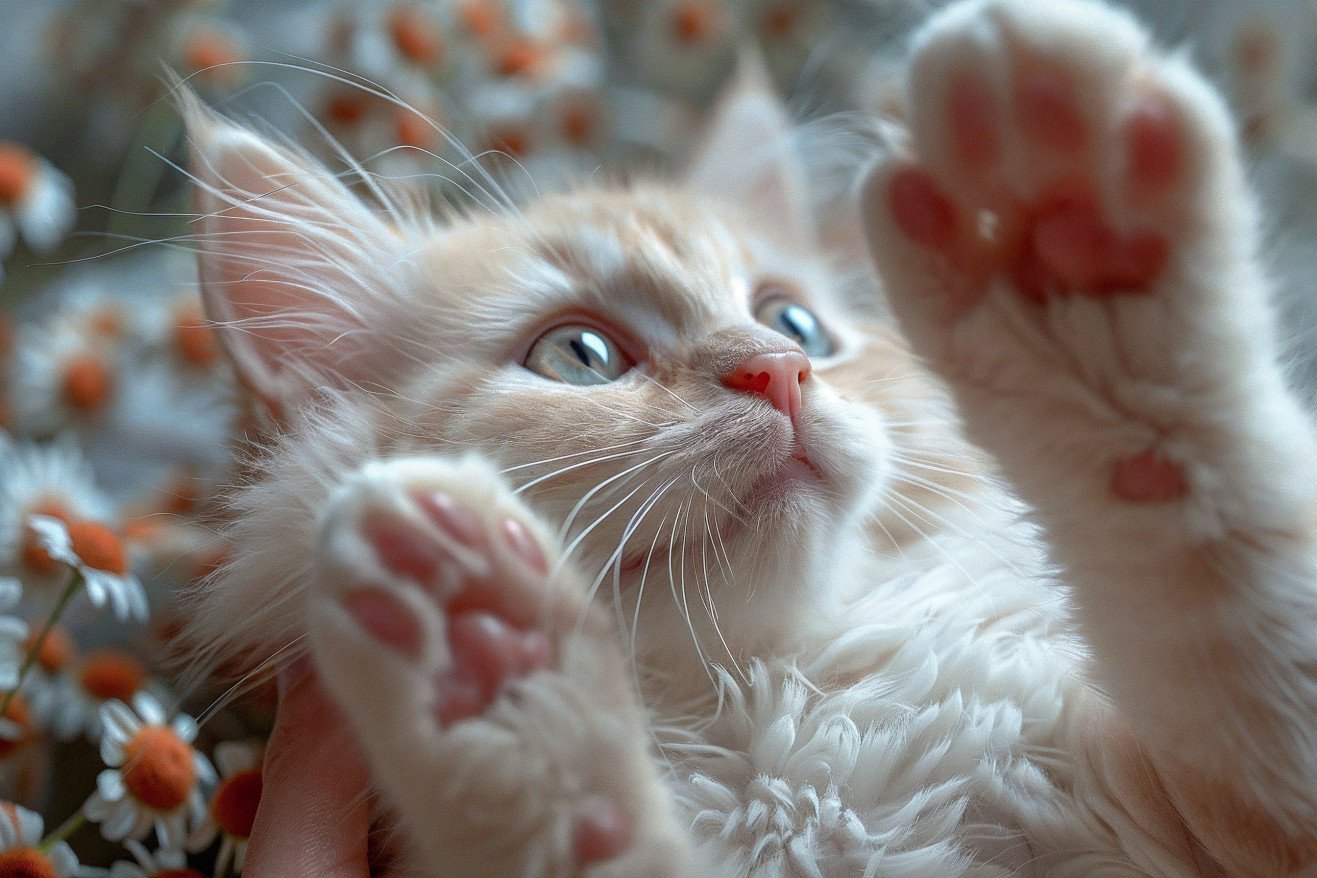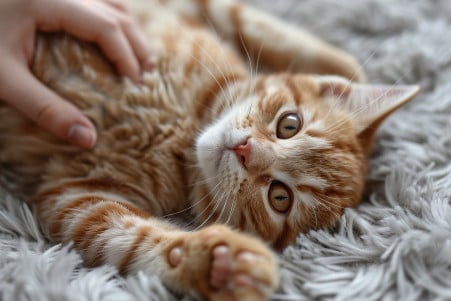Do Cats Get Ticklish? Understanding How Cats Respond to Touch
20 February 2024 • Updated 19 February 2024

If you’ve ever had a cat, you’ve probably wondered at some point—can cats get ticklish? The answer is yes, cats can get ticklish. Cats can experience a form of ticklishness called knismesis, and they are especially sensitive to light tickling around their face and head. Cats can show that they like being tickled through a variety of responses, including purring and kneading.
In the sections below, we will take a deep dive into the world of ticklishness in cats by looking at the latest animal behavior research, neuroscience, and sensory physiology. We will discuss research on how cats respond to touch, the neurological processes that underlie these responses, and why these experiences have evolved.
Through this scientific investigation, we hope to shed light on what ticklishness means for cats and how it impacts their overall health and ability to communicate.
Do cats get ticklish?
The Science of Tickling: How Cats Experience Being Tickled
Cats have a highly developed nervous system, similar to that of humans, which processes touch and other sensations associated with tickling. Studies in animal neuroscience have shown that the somatosensory cortex plays a major role in processing tactile stimuli, including those related to tickling. A study posted in PubMed demonstrated that the somatosensory cortex is activated in rats during tickling, although the exact relationship has yet to be fully established in cats.
While we can’t ask cats how they feel, behavioral similarities with rats and other animals can provide important clues. For example, the playful reactions of cats to light touches, which are similar to the ultrasonic vocalizations of tickled rats, as described in ScienceDirect, indicate that there is a common neurological basis.
However, the neurological processes that underlie a cat’s experience of being tickled may not be the same as those in humans, where ticklish laughter is associated with the activation of certain brain regions, including the hypothalamus and the parietal operculum, according to a study published in Cerebral Cortex.
This knowledge is important because the neurological processes that underlie ticklishness can have a significant impact on a cat’s behavior and well-being. Research into the neural basis of ticklishness may help improve our interactions with our animal companions, thereby increasing their overall happiness and well-being.
The Evolutionary Mystery of Cat Ticklishness
The mystery of why cats are ticklish could be due to evolutionary benefits similar to those in humans and other animals. Forbes quoted a Quora response from neuroscientist Fabian van den Berg, who suggested that ticklishness could have evolved as a defense mechanism to warn an animal of potential threats on its skin. Meanwhile, knismesis could help cats bond socially, as gargalesis does for humans, by helping to strengthen relationships through play.
As Popular Science pointed out, ticklish spots often overlap with sensitive parts of the body, which could mean that they evolved to help animals learn to protect these areas. Meanwhile, in cats, the roughhousing that happens during tickling could help them learn to protect their sensitive areas, essentially combining play with predator defense training.
According to Vox, animal behavior research has continued to build on the social and communicative aspects of ticklishness, further supporting the idea that it’s a reflex with roots in survival and social behavior. This research suggests that in cats, ticklishness may not just be a fun quirk but instead have evolutionary implications that affect their sensory experiences and social lives.
How Cats Experience Touch: Tactile Sensitivity Explained
Cats are tactile animals and their sense of touch is highly developed, thanks to a complex system of tactile receptors. As noted in a paper from PMC, these receptors, which are found in high concentrations in the paw pads and whiskers, are especially good at detecting changes in pressure and texture.
In fact, these tactile receptors are so fine-tuned that cats can detect even the most minute changes, which may help explain why they react so strongly to tickling.
According to ScienceDirect, research on the behavioral assessment of the tactile pad receptor systems has shown that the paw pads are more sensitive than the skin that surrounds them. This heightened sensitivity allows cats to more effectively interact with their environment and discern between different types of touch, from the gentle touch of their human to the strange sensation of being tickled.
The feline nervous system is highly adept at processing tactile stimuli, allowing cats to respond to different types of touch with precision. This is evidenced by the way cats react when their whiskers come into contact with an object or when their paws touch an unfamiliar texture. As noted in the PMC paper, the tactile feedback from the paw pads is essential for environmental interaction and for maintaining balance and stability.
Knowing how a cat’s physiological systems, including their tactile systems, work, including how they respond to tickling, can help cat owners understand their pet’s comfort levels and limitations.
For example, while some cats may enjoy being petted with a light touch in specific areas, others may find the same type of touch overstimulating. Recognizing and accommodating these differences in tactile sensitivity can help strengthen the bond between cats and their human family members, leading to more positive and rewarding relationships.
How Cats Communicate Through Touch and Sensory Stimuli
Cats are known for their highly sensitive perception and response to sensory stimuli, and this sensitivity is important in their interactions with both humans and other cats.
A study published in Scientific Reports found that cats have developed specific ways of communicating with humans, including facial expressions and vocalizations, that demonstrate their ability to engage in complex interspecies communication. They also respond to the emotional content of human communication, reacting differently to cues that indicate happiness and those that indicate distress.
Touch is an especially important part of cats’ communication with humans. Cats often use gentle nudges, rubs, or pats to show affection or to ask for attention, and this can include asking for a response to a ticklish sensation.
When a cat is tickled, its response to the sensation is often easy to read from its body language, which can range from a relaxed posture to the position of its ears, and this can help an attentive owner understand whether the cat is enjoying the interaction.
This sensitivity to touch helps cats interact with their surroundings and the people in their lives, and it’s possible that their response to ticklish sensations is another way that they’ve developed to help them communicate.
Understanding these forms of communication can help cat owners better understand their pets and improve their relationships with them. And as we learn more about the ways cats perceive the world, we can’t help but wonder how these perceptions affect their play and hunting behaviors, two other instinctual behaviors that may be related to their experience of ticklishness.
The Playful Hunting Sequence of Cats
The complex play and predatory behaviors of cats may help explain their ticklish responses. According to VCA Animal Hospitals, play-related aggression, which is a common part of feline behavior, often involves the components of a cat’s predatory behavior, including stalking, pouncing, and biting.
While these behaviors can be seen as aggressive, they are part of a cat’s normal play and may be similar to the responses we see when they are tickled. In terms of ticklishness, the playful swatting and pouncing may be an instinctual way of practicing these predatory behaviors.
A study on ScienceDirect notes that there are behaviors like stalking and pouncing in domestic cats that are part of the cat’s play sequence rather than the hunting sequence. This play sequence, which is similar to the predatory sequence, may be where the cat’s ticklish responses come in, as they feel a light, unpredictable touch and respond in a way that’s similar to how they would interact with prey.
Meanwhile, a study in Applied Animal Behaviour Science, cited by Fear Free Pets, found that cat play behavior is almost identical to hunting behavior and that the stimulating tactile input from tickling may cause cats to respond with instinctual predatory play behaviors.
So when we see cats playing with toys that resemble prey, their ticklish behavior may be another example of these instinctual behaviors. In light of the psychological and physiological components of play, it’s possible that ticklish responses are rooted in a cat’s natural predatory instincts.
Cracking the Cat Tickle: A Definitive Purr-spective
After our deep dive into the world of cat ticklishness, we can conclude that cats do experience the phenomenon of knismesis. This light tickle is often well-received by our furry friends and is the result of a complex system of tactile receptors and a highly evolved nervous system that is similar to other animals, according to studies from PubMed and ScienceDirect.
Understanding the signs of a cat’s body language is key to understanding if they are enjoying the tickle or not. When you put all of these neurological, evolutionary, and behavioral factors together, you get a more complete picture of ticklishness and how it could be involved in social bonding, predator detection, and play and predatory mimicry.
For those who live with and care for cats, understanding the subtleties of how cats respond to touch can help you build a stronger relationship and provide better care. As we continue to explore the world of cats and their sensitivities, let’s keep learning and paying attention so we can enrich the lives of our cats and ourselves with every gentle touch and playful tickle.


